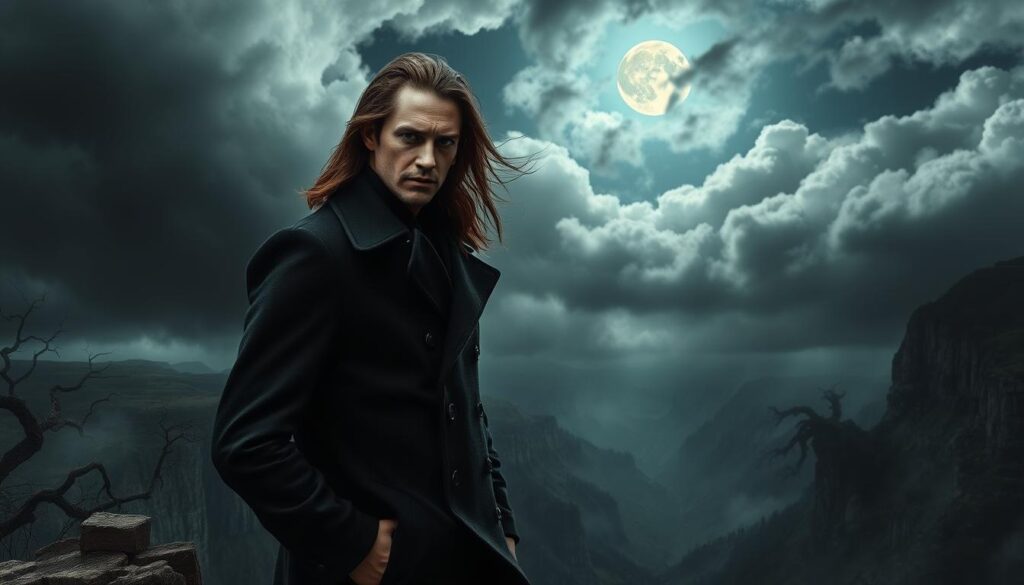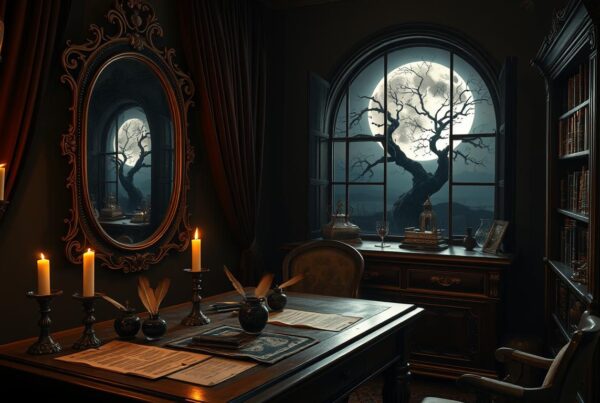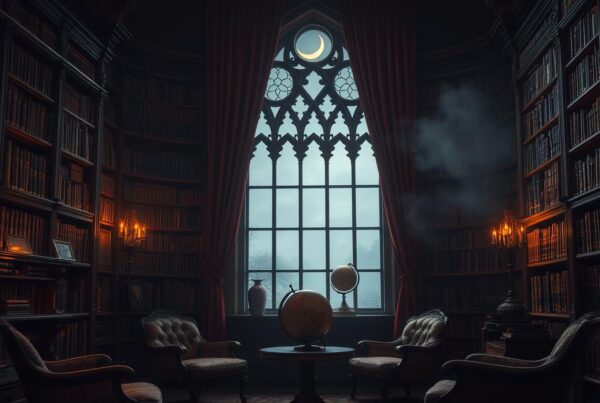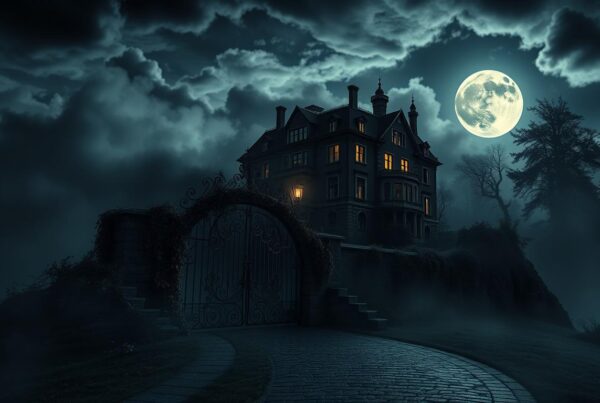Gothic literature draws us in with its dark and mysterious worlds. At its core are unforgettable character archetypes. These figures, from brooding heroes to complex villains, bring gothic romance to life.
The charm of gothic tales lies in their mix of romance and horror. We’re pulled into atmospheric castles and misty moors, where danger is always near. It’s here that iconic characters appear, each playing a key role in the story.
Exploring gothic literature, we meet a variety of characters. There are tortured heroes and cunning villains, all embodying dark romance. Their complex stories and struggles add depth to the genre, making these tales unforgettable.
The Evolution of Gothic Romance Characters
Gothic romance characters have changed a lot since they first appeared. They started in the late 18th century, drawing in readers with their mystery. As time went on, these characters became more complex, showing the changes in society and art.
At first, gothic stories had simple characters like the damsel in distress and the dark hero. But soon, writers started making their characters more detailed. The Victorian era brought even more depth, with characters that were not always good or bad.
Now, gothic romance characters keep changing, mixing old and new themes. Today’s readers meet heroes with deep struggles, villains with stories, and heroines who break the mold. This keeps the genre fresh and exciting for all.
Brooding Heroes: The Quintessential Gothic Protagonists
Gothic romance draws us in with its dark charm and deep characters. At its core, we meet brooding heroes. They are the heart of tragic protagonists. Their mysterious pasts and inner struggles leave a mark on us.
The Byronic Hero Archetype
The Byronic hero is key in gothic stories. Named after Lord Byron, they are charismatic and rebellious. They have a pull that draws people in, despite their flaws.
Byronic heroes challenge the status quo and fight their inner battles. This makes them both captivating and a bit scary.

Tortured Souls and Dark Pasts
Gothic heroes often carry heavy burdens from their pasts. These souls are haunted by guilt, regret, or secrets. Their dark histories add mystery and depth to their stories.
Readers are drawn to these characters, eager to learn about their pain. They hope to find the truth behind their struggles.
Examples from Classic Gothic Literature
Classic gothic novels give us iconic brooding heroes. Heathcliff from “Wuthering Heights” is a passionate, vengeful lover. Rochester in “Jane Eyre” is a mysterious figure with a hidden past.
These characters still captivate us today. They set the stage for modern tragic protagonists in gothic stories.
Damsels in Distress: The Traditional Gothic Heroine
Gothic literature shows women in danger. The classic gothic heroine is often trapped in a dark castle. She faces threats from both humans and ghosts.
These women are seen as pure and good. They move through dangerous places full of secrets. Despite being helpless at first, they grow strong.
The idea of being a victim is big in gothic romance. Heroines often get hurt by bad people or bad luck. But their stories connect with readers, making gothic tales popular.
Over time, female characters in gothic stories have changed. Today’s heroines are still vulnerable but also more powerful. They break away from the old damsel in distress idea, making gothic literature more interesting.
Iconic Characters in Gothic Romance: From Heroes to Villains
Gothic romance draws us in with its deep characters. These characters range from dark heroes to complex villains. Their complexity keeps us guessing and hooked.
The Spectrum of Gothic Character Types
Gothic stories have many types of characters. There are tortured heroes and mysterious villains. The Byronic hero is a key figure, showing both good and bad sides.

Blurring the Lines Between Good and Evil
In gothic tales, heroes and villains are not always clear. Characters may seem good at first but show a darker side later. This makes us question what is right and wrong.
Character Development in Gothic Narratives
Gothic stories are great at showing how characters grow. They face supernatural threats or deal with their own demons. This journey shows how complex we are.
The Vengeful Antagonist: Gothic Villains and Their Motivations
Gothic romance loves its bad guys. These villains push the story along with their dark plans. They make us feel scared and keep us guessing.
Gothic villains are many things. Some are rich folks with secrets, others are ghosts wanting to harm. They all want revenge for past hurts.
Revenge stories in gothic tales are complex. Villains might plan for years to get their revenge. They often pick on the hero or heroine, seeing them as reminders of their pain.
The reasons behind gothic villains’ actions are deep. They might be seeking revenge for lost love, betrayal, or being shunned. Their evil deeds come from deep pain. This makes them more than just bad guys – they’re tragic figures.
Gothic villains have a big impact on books. Their dark nature and twisted minds inspire writers and grab readers. They make us face our own dark sides.
Supernatural Beings in Gothic Romance
Gothic romance is all about spooky elements that make you shiver. It’s filled with mythical creatures that mix reality and fantasy. This creates a world of supernatural horror.
Ghosts and Spectral Entities
Ghosts are everywhere in Gothic novels. They show unresolved conflicts or hidden secrets. These spirits make the atmosphere creepy, pushing characters to face their fears and find dark truths.
Vampires and Werewolves
Vampires and werewolves are key in Gothic stories. They show the battle between human and beast. These creatures are often doomed to live in between two worlds.
Demonic Presences
Demons in Gothic romance are the ultimate evil. They tempt characters and test their morals. These evil beings add spiritual conflict, making the story even scarier.
These supernatural beings make Gothic romance more than just stories. They delve into deep fears and desires. This makes the tales both exciting and thought-provoking for readers.
The Gothic Anti-Hero: Sympathy for the Devil
Gothic literature brings us into a world of complex characters. These characters mix good and evil, making it hard to tell who’s right or wrong. They are the gothic anti-heroes, and they pull us into their stories.
Redemption arcs are key in these stories. We want to see them change, even when they face dark choices. This makes their stories both interesting and relatable.
These characters often have sad pasts that shape their actions. Their pain can lead to bad choices, but also to growth. We watch them fight their inner demons, hoping they’ll find redemption.
What makes these characters so appealing is how we can relate to them. They deal with tough choices and mistakes, just like us. Their stories show us the complexity of human nature, offering a fresh look at who we are.
Femme Fatales: Dangerous Women in Gothic Literature
Gothic literature introduces us to powerful women who both captivate and terrify. These female villains defy societal norms, using their charm as a weapon. They are not just pretty faces; they are also smart, cunning, and often more intriguing than the heroes.
Seductresses and Enchantresses
Gothic stories are filled with enchanting women who lure men to their doom. Carmilla from Sheridan Le Fanu’s novella is a vampire who seduces young women. These characters use their beauty and wit to gain power, challenging the idea that women should be passive.
The Power of Female Agency in Gothic Narratives
In gothic tales, these subversive characters often drive the plot. They make choices that shake up the story, showing that women can be more than just victims. Emily Brontë’s Catherine Earnshaw in “Wuthering Heights” is a great example. Her decisions shape the entire narrative.
Notable Examples from Gothic Classics
Many gothic novels feature unforgettable femme fatales. In Bram Stoker’s “Dracula,” Lucy Westenra transforms from an innocent girl into a seductive vampire. Mary Shelley’s “Frankenstein” gives us the tragic figure of Elizabeth Lavenza. These women add depth and complexity to their stories, proving that powerful women can be both fascinating and frightening.


